Tata Steel Bundle
Can Tata Steel Maintain Its Dominance in the Cutthroat Steel Market?
The global steel industry is a battleground of innovation, sustainability demands, and geopolitical shifts. Understanding the Tata Steel SWOT Analysis is crucial to navigating this complex environment. As a leading player, Tata Steel's strategic decisions and market positioning are critical to watch. This analysis dives into the heart of its competitive landscape.
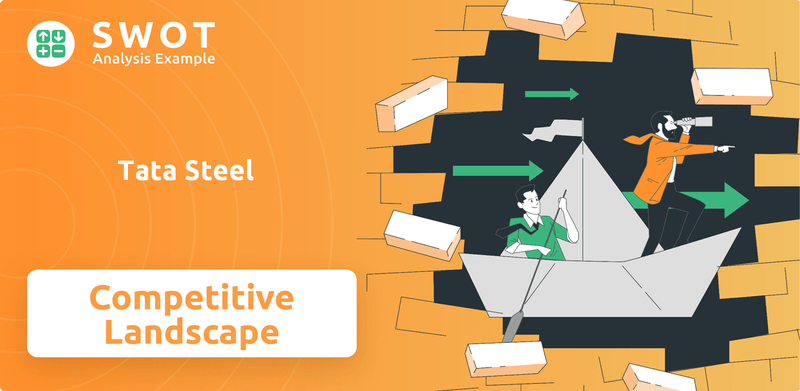
This Tata Steel market analysis explores its key rivals, competitive advantages, and the broader industry trends shaping its future. We'll dissect the Tata Steel competitors and evaluate its competitive strategy to understand its ability to thrive. Analyzing the Indian steel market and global presence, we'll assess how Tata Steel navigates the challenges and opportunities in the steel industry analysis.
Where Does Tata Steel’ Stand in the Current Market?
Tata Steel holds a prominent position in the global steel industry, ranking among the top steel producers worldwide. Its extensive product range, including hot-rolled, cold-rolled, and coated steel, caters to various sectors like automotive and construction. The company's operations span across India, Europe, and Southeast Asia, showcasing a broad geographical footprint in the competitive landscape of Tata Steel.
In India, Tata Steel is a market leader, while also maintaining a significant presence in Europe and Southeast Asia. This global presence allows the company to serve diverse markets and adapt to regional demands. The company's strategic focus on value-added products and green steel production further strengthens its market position for future growth.
In fiscal year 2023-24, Tata Steel reported a consolidated crude steel production of 18.89 million tonnes in India. The company's financial health remains robust, with a consolidated turnover of $33.4 billion in fiscal year 2023. This financial performance reflects its strong market position and operational efficiency in the steel industry.
Tata Steel's core operations involve the production and sale of steel products. These products include hot-rolled, cold-rolled, and coated steel, serving sectors like automotive, construction, and packaging. The company's integrated operations, from raw material sourcing to finished products, ensure quality and efficiency.
Tata Steel offers a diverse product portfolio and a strong global presence. Its value proposition lies in providing high-quality steel products tailored to various industry needs. The company's focus on sustainability and value-added products enhances its competitive edge and meets evolving market demands.
Tata Steel's market share in the Indian steel market is significant, positioning it as a leading player. The company's financial performance, with a turnover of $33.4 billion in fiscal year 2023, demonstrates its strong market position. This financial strength allows Tata Steel to invest in new technologies and expand its operations.
- Tata Steel's crude steel production in India was 18.89 million tonnes in fiscal year 2023-24.
- The company's focus on value-added products contributes to higher profitability.
- Strategic investments in advanced materials and green steel production enhance its competitive advantage.
- Tata Steel's global presence supports its ability to serve diverse markets and mitigate risks.
Tata Steel SWOT Analysis
- Complete SWOT Breakdown
- Fully Customizable
- Editable in Excel & Word
- Professional Formatting
- Investor-Ready Format
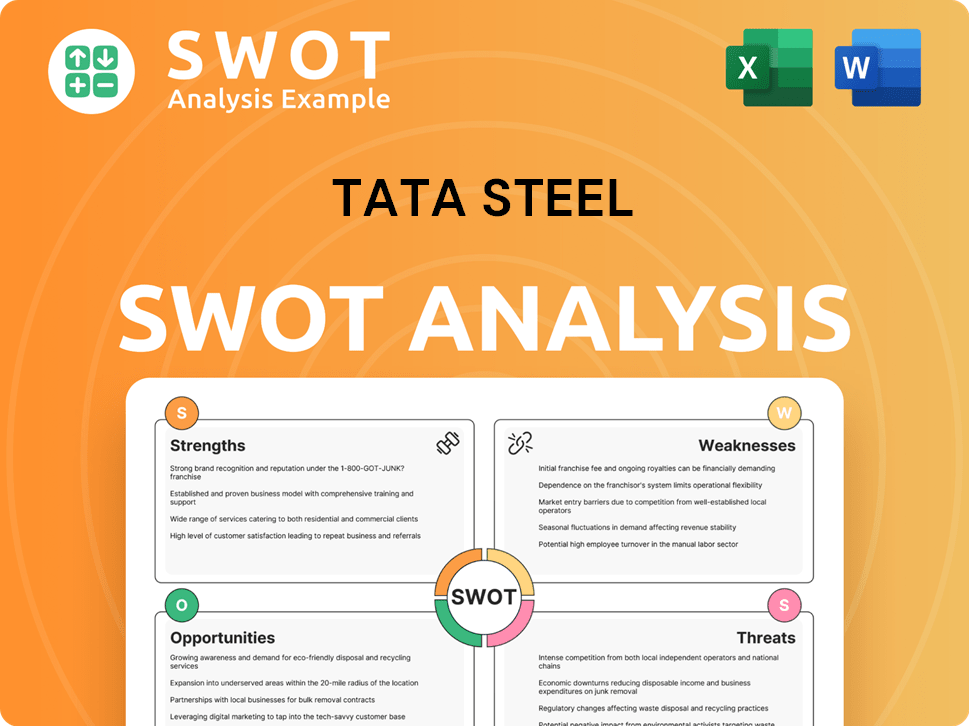
Who Are the Main Competitors Challenging Tata Steel?
The Owners & Shareholders of Tata Steel operates within a fiercely contested global steel market. Understanding the Tata Steel competitive landscape is crucial for assessing its performance and future prospects. This analysis examines the key players and strategic dynamics shaping the steel industry.
Tata Steel competitors face a complex web of challenges, including fluctuating raw material costs, evolving technological demands, and the impact of global economic trends. The company's ability to navigate this environment is critical for maintaining its market position and profitability. A comprehensive Tata Steel market analysis reveals the competitive pressures and opportunities that influence its strategic decisions.
Tata Steel's primary direct competitors include major global steel producers. These companies often compete across various product segments and geographical regions, influencing market dynamics and pricing strategies. These rivals are constantly innovating and adapting, creating a dynamic competitive environment.
ArcelorMittal is the world's largest steel producer, posing a significant challenge to Tata Steel. ArcelorMittal competes directly with Tata Steel in Europe and other key markets. In 2024, ArcelorMittal reported revenues of approximately $68.3 billion.
Nippon Steel Corporation, a leading Asian steelmaker, is a key competitor, especially in high-grade steel and the automotive sector. Nippon Steel's focus on technological advancements gives it a competitive edge. In fiscal year 2024, Nippon Steel's revenue reached approximately $57 billion.
POSCO, another major Asian steel producer, competes with Tata Steel in various markets. POSCO is known for its technological prowess and efficiency in steel production. POSCO's revenue in 2024 was around $60 billion.
JSW Steel is a significant domestic player in the rapidly growing Indian market. JSW Steel competes directly with Tata Steel within India, focusing on market share in the expanding domestic steel sector. JSW Steel reported revenues of approximately $18.8 billion in fiscal year 2024.
SAIL, another major Indian steel producer, competes with Tata Steel for market share within India. SAIL's operations are primarily focused on the Indian market, making it a key domestic competitor. SAIL's revenue in fiscal year 2024 was approximately $9.2 billion.
Indirect competition comes from alternative materials like aluminum and composites. These materials are gaining adoption in sectors traditionally dominated by steel, such as automotive and construction. The shift towards lighter and sustainable materials impacts steel demand.
Several factors influence the competitive dynamics within the steel industry analysis. These factors shape Tata Steel's competitive strategy and its ability to maintain or improve its market position. Understanding these elements is crucial for assessing Tata Steel's strengths and weaknesses compared to rivals.
- Market Share: ArcelorMittal holds the largest market share globally, followed by Nippon Steel and POSCO. Tata Steel's market share is significant in India and certain international markets.
- Technological Advancements: Nippon Steel and POSCO are known for their technological prowess, which gives them a competitive edge in high-grade steel production. Tata Steel's technological advancements and competitive edge are crucial.
- Pricing Strategy: Tata Steel's pricing strategy vs competitors is influenced by global steel prices, raw material costs, and demand.
- Sustainability Initiatives: Tata Steel's sustainability initiatives and competitive landscape are becoming increasingly important, with a focus on reducing carbon emissions and adopting sustainable practices.
- Global Presence: Tata Steel's global presence and competition are affected by geopolitical factors, trade policies, and regional economic conditions.
- Acquisitions and Consolidation: Tata Steel's acquisitions and their impact on competition, along with industry consolidation, shape the competitive landscape.
Tata Steel PESTLE Analysis
- Covers All 6 PESTLE Categories
- No Research Needed – Save Hours of Work
- Built by Experts, Trusted by Consultants
- Instant Download, Ready to Use
- 100% Editable, Fully Customizable
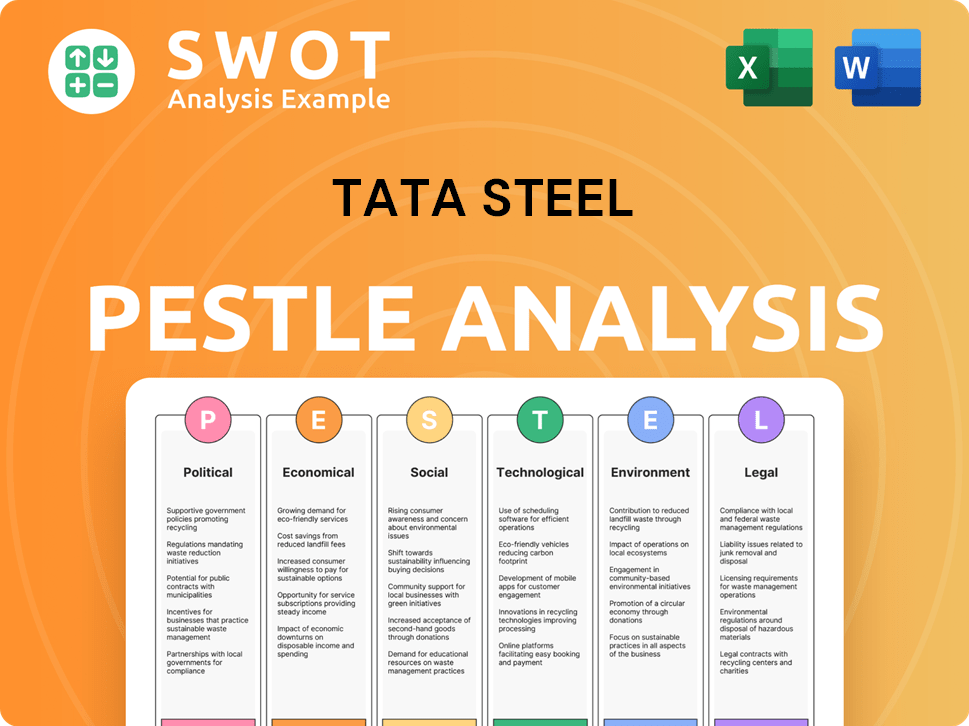
What Gives Tata Steel a Competitive Edge Over Its Rivals?
The competitive advantages of Tata Steel are rooted in its integrated operations, strong brand reputation, and commitment to innovation. These strengths enable the company to maintain a robust position within the steel industry. Understanding the Tata Steel competitive landscape requires an analysis of these core advantages and how they contribute to its market performance. The company's strategic approach and operational efficiencies are key factors in its ability to compete effectively.
Tata Steel benefits significantly from its captive iron ore mines in India, providing a stable and cost-effective supply of raw materials. This vertical integration ensures greater control over production costs compared to competitors that rely on external sourcing. Furthermore, its extensive distribution network and established relationships with diverse customer segments across various industries like automotive, construction, and engineering, further solidify its market position. Analyzing the Tata Steel competitors reveals how these advantages contribute to its overall market share and strategic positioning.
Brand equity and customer loyalty, built over more than a century of operation, are also significant assets. Tata Steel has consistently invested in research and development, leading to proprietary technologies and a portfolio of high-value-added products. The company's focus on sustainable steel production is increasingly becoming a competitive differentiator, attracting environmentally conscious customers and investors. For a deeper dive into how the company plans to grow, check out the Growth Strategy of Tata Steel.
Tata Steel has a long history, starting in 1907, and has expanded globally. The company has made significant acquisitions and investments to strengthen its market position. This includes strategic moves to enhance its product portfolio and operational capabilities, focusing on technological advancements.
Recent strategic moves include investments in sustainable steel production and digital transformation. The company focuses on expanding its presence in high-growth markets. These moves are designed to improve efficiency and reduce environmental impact, aligning with global trends.
Tata Steel's competitive edge is derived from its integrated operations and diverse product offerings. The company's focus on innovation and sustainability sets it apart. Its strong brand recognition and customer loyalty are also key differentiators in the steel industry analysis.
The Indian steel market is a key focus for Tata Steel, with significant investments and market share. The company's global presence allows it to capitalize on international opportunities. It continually adapts its strategies to maintain its competitive position.
Tata Steel's competitive advantages encompass several key areas, including operational efficiency, brand strength, and innovation. These factors contribute to its ability to outperform competitors in the global market. Understanding these advantages is crucial for a comprehensive Tata Steel market analysis.
- Integrated Operations: Captive iron ore mines provide a stable and cost-effective supply of raw materials, reducing reliance on external sources.
- Brand Equity and Customer Loyalty: Built over a century, the brand enjoys strong recognition and trust.
- Innovation and Technology: Investments in R&D lead to proprietary technologies and high-value-added products.
- Sustainability Initiatives: Focus on reducing carbon emissions and promoting a circular economy attracts environmentally conscious customers and investors.
Tata Steel Business Model Canvas
- Complete 9-Block Business Model Canvas
- Effortlessly Communicate Your Business Strategy
- Investor-Ready BMC Format
- 100% Editable and Customizable
- Clear and Structured Layout
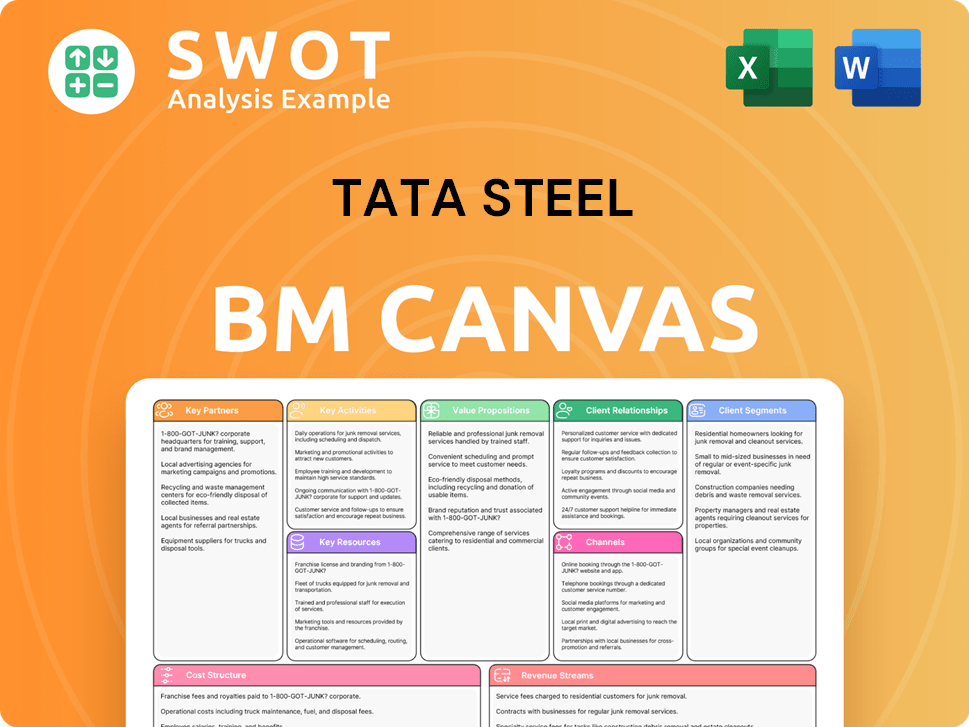
What Industry Trends Are Reshaping Tata Steel’s Competitive Landscape?
The competitive landscape of Tata Steel is currently shaped by the global steel industry's dynamic nature. This includes industry-wide trends like the push for decarbonization, digitalization, and the development of advanced materials. These factors influence Tata Steel's strategic decisions, impacting its market position, financial performance, and future outlook.
Tata Steel faces risks such as volatile raw material prices and the high capital expenditure needed for sustainable practices. However, it also has opportunities, particularly in the growing Indian market and the demand for specialized steels. Understanding these aspects is crucial for assessing Tata Steel's competitive advantage and long-term prospects.
The steel industry is undergoing significant shifts. Key trends include the drive for decarbonization through technologies like hydrogen-based steelmaking, and increased automation to improve efficiency. Digitalization and the rise of advanced materials are also playing a crucial role.
Tata Steel faces challenges such as the high capital costs associated with green steel transitions and managing volatile raw material prices. Geopolitical shifts and the restructuring of operations in high-cost regions, like the UK, also pose significant hurdles.
Emerging markets, especially India, offer substantial growth opportunities due to infrastructure development. The increasing demand for specialized steels in sectors like renewable energy provides additional avenues for expansion. Strategic partnerships and innovation are key.
Tata Steel aims to strengthen its competitive position by focusing on innovation, strategic partnerships, and sustainable practices. This focus is intended to ensure long-term resilience in a rapidly evolving global industry. This includes a focus on operational excellence.
The steel industry's future hinges on how companies like Tata Steel navigate sustainability and technological advancements. The Indian steel market is a crucial area for growth, with Tata Steel's competitive strategy heavily influenced by its performance there.
- Decarbonization: Implementing green steel technologies to reduce carbon emissions. In 2024, the company invested heavily in sustainable practices.
- Market Dynamics: Capitalizing on the growth in the Indian steel market, which is expected to grow by 6-8% in 2025.
- Innovation: Developing and offering advanced steel products for sectors like electric vehicles and renewable energy, a market expected to reach $100 billion by 2030.
- Strategic Partnerships: Forming alliances to enhance technology transfer and market access.
Tata Steel Porter's Five Forces Analysis
- Covers All 5 Competitive Forces in Detail
- Structured for Consultants, Students, and Founders
- 100% Editable in Microsoft Word & Excel
- Instant Digital Download – Use Immediately
- Compatible with Mac & PC – Fully Unlocked
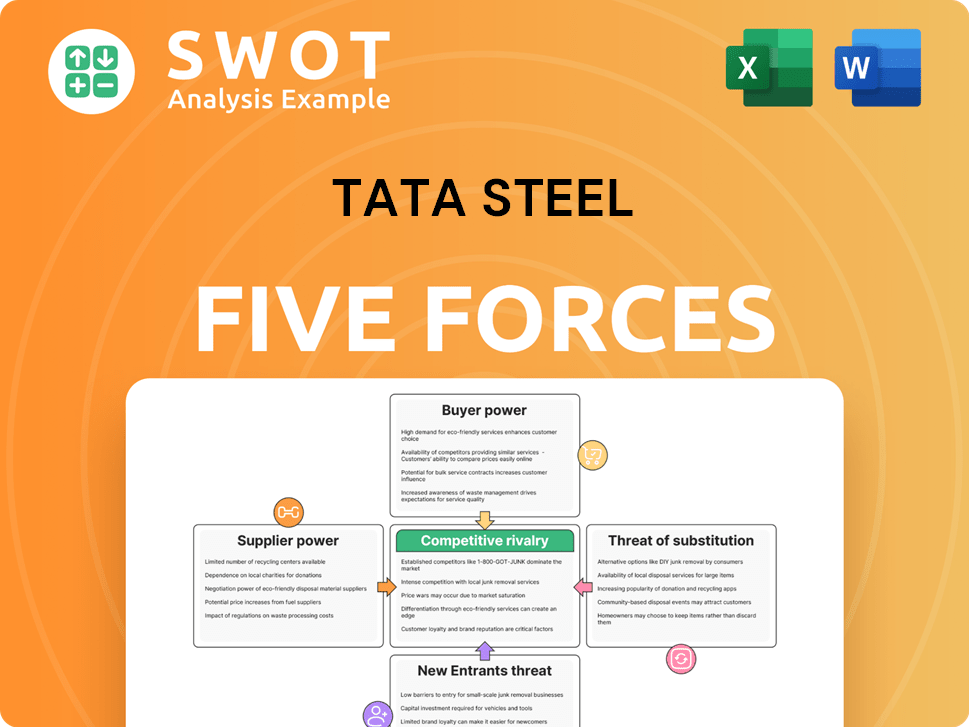
Related Blogs
- What are Mission Vision & Core Values of Tata Steel Company?
- What is Growth Strategy and Future Prospects of Tata Steel Company?
- How Does Tata Steel Company Work?
- What is Sales and Marketing Strategy of Tata Steel Company?
- What is Brief History of Tata Steel Company?
- Who Owns Tata Steel Company?
- What is Customer Demographics and Target Market of Tata Steel Company?
Disclaimer
All information, articles, and product details provided on this website are for general informational and educational purposes only. We do not claim any ownership over, nor do we intend to infringe upon, any trademarks, copyrights, logos, brand names, or other intellectual property mentioned or depicted on this site. Such intellectual property remains the property of its respective owners, and any references here are made solely for identification or informational purposes, without implying any affiliation, endorsement, or partnership.
We make no representations or warranties, express or implied, regarding the accuracy, completeness, or suitability of any content or products presented. Nothing on this website should be construed as legal, tax, investment, financial, medical, or other professional advice. In addition, no part of this site—including articles or product references—constitutes a solicitation, recommendation, endorsement, advertisement, or offer to buy or sell any securities, franchises, or other financial instruments, particularly in jurisdictions where such activity would be unlawful.
All content is of a general nature and may not address the specific circumstances of any individual or entity. It is not a substitute for professional advice or services. Any actions you take based on the information provided here are strictly at your own risk. You accept full responsibility for any decisions or outcomes arising from your use of this website and agree to release us from any liability in connection with your use of, or reliance upon, the content or products found herein.